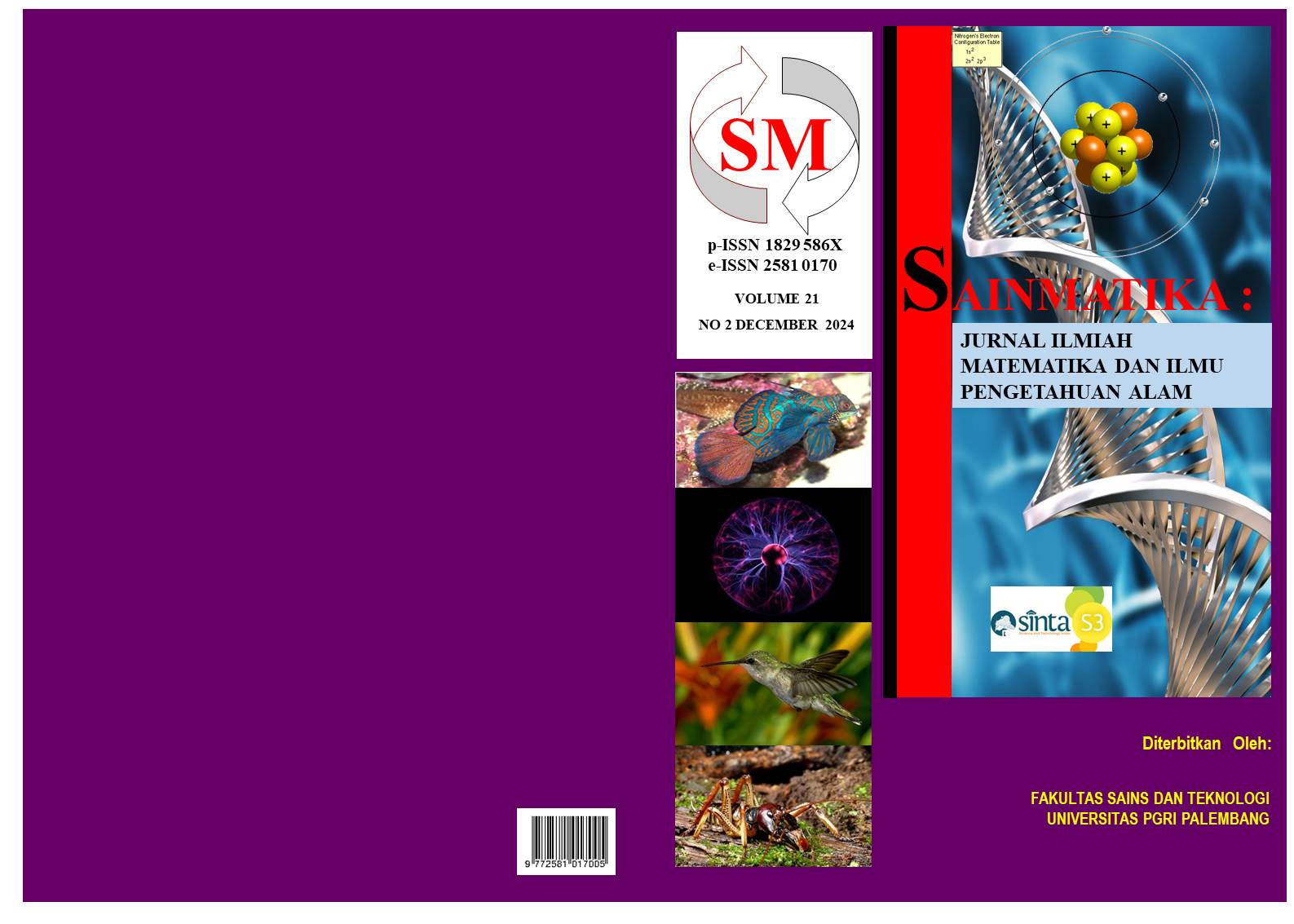Optimization of Palm Shell Drying to Enhance Adsorption Performance: A Kinetic Study and Exponential Model
DOI:
https://doi.org/10.31851/sainmatika.v21i2.16722Keywords:
Palm Shell, Drying, Adsorption, Moisture Ratio, Exponential ModelAbstract
Palm shell has great potential as an adsorbent material due to its porosity and thermal stability, but its high moisture content can affect its surface area and absorption capacity. This study aims to optimize the drying process of palm shells to enhance their adsorption performance by applying an exponential model. The drying process was carried out at a temperature of 80°C with time variations ranging from 1 to 6 hours. Parameters measured included wet and dry moisture content, Moisture Ratio (MR), and drying rate. The results showed that drying the palm shell for 4 hours yielded the best results, with a reduction in wet moisture content by 19-21% and dry moisture content by 23-28%. The exponential model analysis provided drying rate constants for the three samples of 0.0443, 0.0238, and 0.0159, respectively. The measured MR graph compared with the model predictions showed a very good fit, with an R² value close to 1, meaning the exponential model is effective in predicting the drying rate. Adsorption performance was tested using a Dylon dye solution with a concentration of 25 ppm, where the palm shell was able to adsorb up to 85% of the dye within 180 minutes.
References
Aksoy, A., Karasu, S., Akcicek, A., & Kayacan, S. (2019). Effects of different drying methods on drying kinetics, microstructure, color, and the rehydration ratio of minced meat. Foods, 8(6). https://doi.org/10.3390/foods8060216
Alsulami, R. A., El-Sayed, S. A., Eltaher, M. A., Mohammad, A., Almitani, K. H., & Mostafa, M. E. (2023). Thermal decomposition characterization and kinetic parameters estimation for date palm wastes and their blends using TGA. Fuel, 334. https://doi.org/10.1016/j.fuel.2022.126600
Andrade, C., Delgado, J. M. P. Q., & Mesquita, E. F. T. (2022). Modeling and simulation of drying kinetics/curves: application to building materials. Journal of Building Pathology and Rehabilitation, 7(8).
Boateng, I. D., & Yang, X. M. (2021). Process optimization of intermediate-wave infrared drying: Screening by Plackett–Burman; comparison of Box-Behnken and central composite design and evaluation: A case study. Industrial Crops and Products, 162. https://doi.org/10.1016/j.indcrop.2021.113287
Broda, M., Curling, S. F., & Frankowski, M. (2021). The effect of the drying method on the cell wall structure and sorption properties of waterlogged archaeological wood. Wood Science and Technology, 55(4), 971–989. https://doi.org/10.1007/s00226-021-01294-6
Bulavchenko, O. A., & Vinokurov, Z. S. (2023). In Situ X-ray Diffraction as a Basic Tool to Study Oxide and Metal Oxide Catalysts. In Catalysts (Vol. 13, Issue 11). Multidisciplinary Digital Publishing Institute (MDPI). https://doi.org/10.3390/catal13111421
Dolah, R., Karnik, R., & Hamdan, H. (2021). A comprehensive review on biofuels from oil palm empty bunch (Efb): Current status, potential, barriers and the way forward. In Sustainability (Switzerland) (Vol. 13, Issue 18). MDPI. https://doi.org/10.3390/su131810210
Gayathiri, M., Pulingam, T., Lee, K. T., & Sudesh, K. (2022). Activated carbon from biomass waste precursors: Factors affecting 1 production and adsorption mechanism.
Macedo, L. L., Vimercati, W. C., Araújo, C. da S., Saraiva, S. H., & Teixeira, L. J. Q. (2024). Effect of drying air temperature on drying kinetics and physicochemical characteristics of dried banana. Food Process Engineering, 47(9).
Mehdipour-Ataei, S., & Aram, E. (2023). Mesoporous Carbon-Based Materials: A Review of Synthesis, Modification, and Applications. In Catalysts (Vol. 13, Issue 1). MDPI. https://doi.org/10.3390/catal13010002
Mortada, W. I., Mohamed, R. A., Monem, A. A. A., Awad, M. M., & Hassan, A. F. (2023). Effective and Low-Cost Adsorption Procedure for Removing Chemical Oxygen Demand from Wastewater Using Chemically Activated Carbon Derived from Rice Husk. Separations, 10(1). https://doi.org/10.3390/separations10010043
Radojčin, M., Pavkov, I., Kovačević, D. B., Putnik, P., Wiktor, A., Stamenković, Z., Kešelj, K., & Gere, A. (2021). Effect of selected drying methods and emerging drying intensification technologies on the quality of dried fruit: A review. In Processes (Vol. 9, Issue 1, pp. 1–21). MDPI AG. https://doi.org/10.3390/pr9010132
Setiajiati, F., Nurrochmat, D. R., Van Assen, B. W., & Purwawangsa, H. (2024). Current status of Indonesia’s palm oil products and their competitiveness in the global market. IOP Conference Series: Earth and Environmental Science, 1379(1). https://doi.org/10.1088/1755-1315/1379/1/012022
Thao, B. T. T., Vo, T. T. K., Tran, T. Y. N., Le, D. T., Tran, T. T., Bach, L. G., & Dao, T. P. (2023). Application of mathematical techniques to study the moisture loss kinetics and polyphenol degradation kinetics of mango (Mangifera indica L.) slices during heat pump drying by pilot equipment. LWT, 176. https://doi.org/10.1016/j.lwt.2023.114454
Uchegbulam, I., Momoh, E. O., & Agan, S. A. (2022). Potentials of palm kernel shell derivatives: a critical review on waste recovery for environmental sustainability. In Cleaner Materials (Vol. 6). Elsevier Ltd. https://doi.org/10.1016/j.clema.2022.100154
Velusamy, S., Roy, A., Sundaram, S., & Kumar Mallick, T. (2021). A Review on Heavy Metal Ions and Containing Dyes Removal Through Graphene Oxide-Based Adsorption Strategies for Textile Wastewater Treatment. In Chemical Record (Vol. 21, Issue 7, pp. 1570–1610). John Wiley and Sons Inc. https://doi.org/10.1002/tcr.202000153
Wang, B., Lan, J., Bo, C., Gong, B., & Ou, J. (2023). Adsorption of heavy metal onto biomass-derived activated carbon: review. In RSC Advances (Vol. 13, Issue 7, pp. 4275–4302). Royal Society of Chemistry. https://doi.org/10.1039/d2ra07911a
Wu, Z., Zhu, G., Peng, M., Zhu, Y., Miao, W., Li, D., Qin, D., Ma, P., & Chen, F. (2024). Kinetic analysis and calculation correction methods for moisture evaporation rate in pine lignocellulosic biomass. Case Studies in Thermal Engineering, 61. https://doi.org/10.1016/j.csite.2024.104985
Xu, K., Li, Y., Xiong, J., Ou, X., Su, W., Zhong, G., & Yang, C. (2018). Activated Amorphous Carbon With High-Porosity Derived From Camellia Pollen Grains as Anode Materials for Lithium/Sodium Ion Batteries. Frontiers in Chemistry, 6. https://doi.org/10.3389/fchem.2018.00366
Yek, P. N. Y., Liew, R. K., Osman, M. S., Lee, C. L., Chuah, J. H., Park, Y. K., & Lam, S. S. (2019). Microwave steam activation, an innovative pyrolysis approach to convert waste palm shell into highly microporous activated carbon. Journal of Environmental Management, 236, 245–253. https://doi.org/10.1016/j.jenvman.2019.01.010
Yim, Y. J., & Kim, B. J. (2023). Preparation and Characterization of Activated Carbon/Polymer Composites: A Review. In Polymers (Vol. 15, Issue 16). Multidisciplinary Digital Publishing Institute (MDPI). https://doi.org/10.3390/polym15163472
Zhang, Q., Ye, Q., Zhang, Y., Cai, Q., Dang, Y., Pang, H., & Wu, X. (2022). High efficiency solar interfacial evaporator for seawater desalination based on high porosity loofah sponge biochar. Solar Energy, 238, 305–314. https://doi.org/10.1016/j.solener.2022.04.044

Downloads
Published
Issue
Section
License

This work is licensed under a Creative Commons Attribution-NonCommercial-ShareAlike 4.0 International License.








